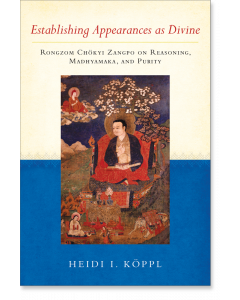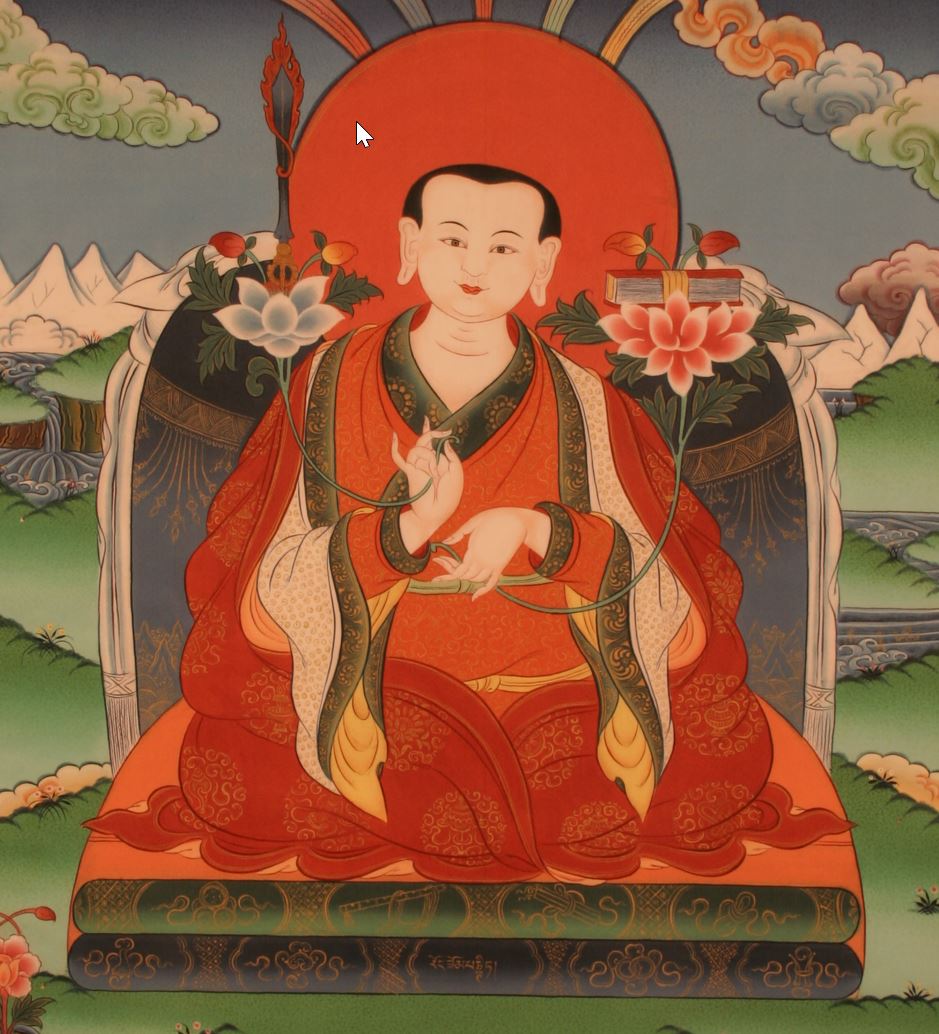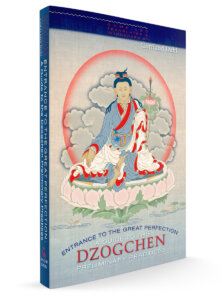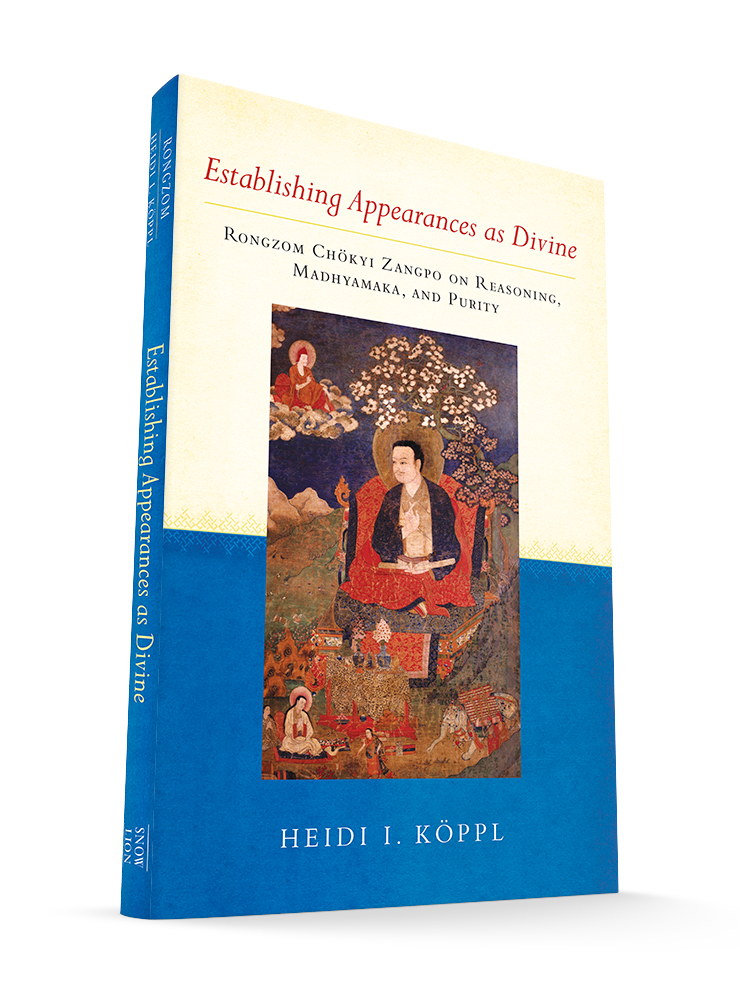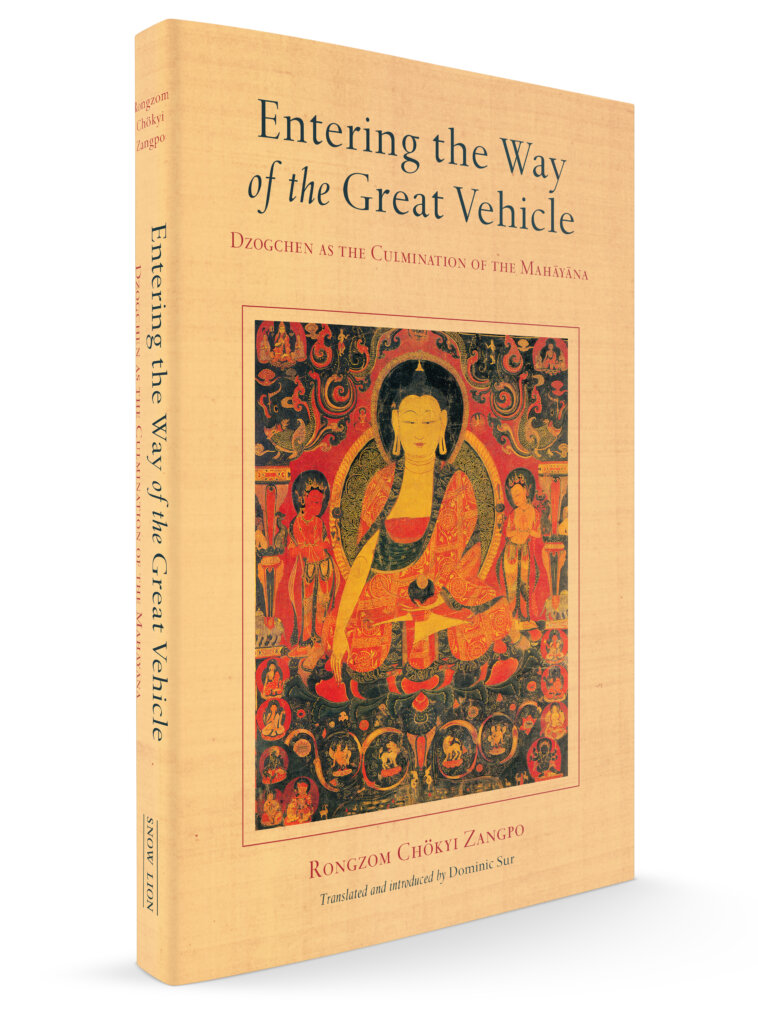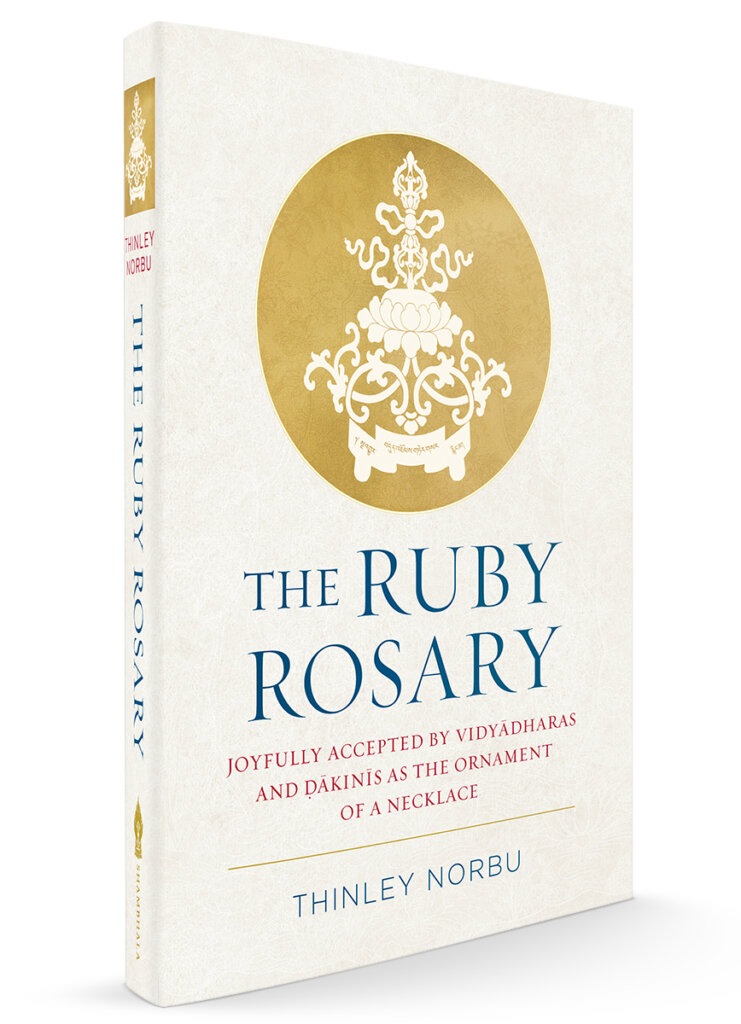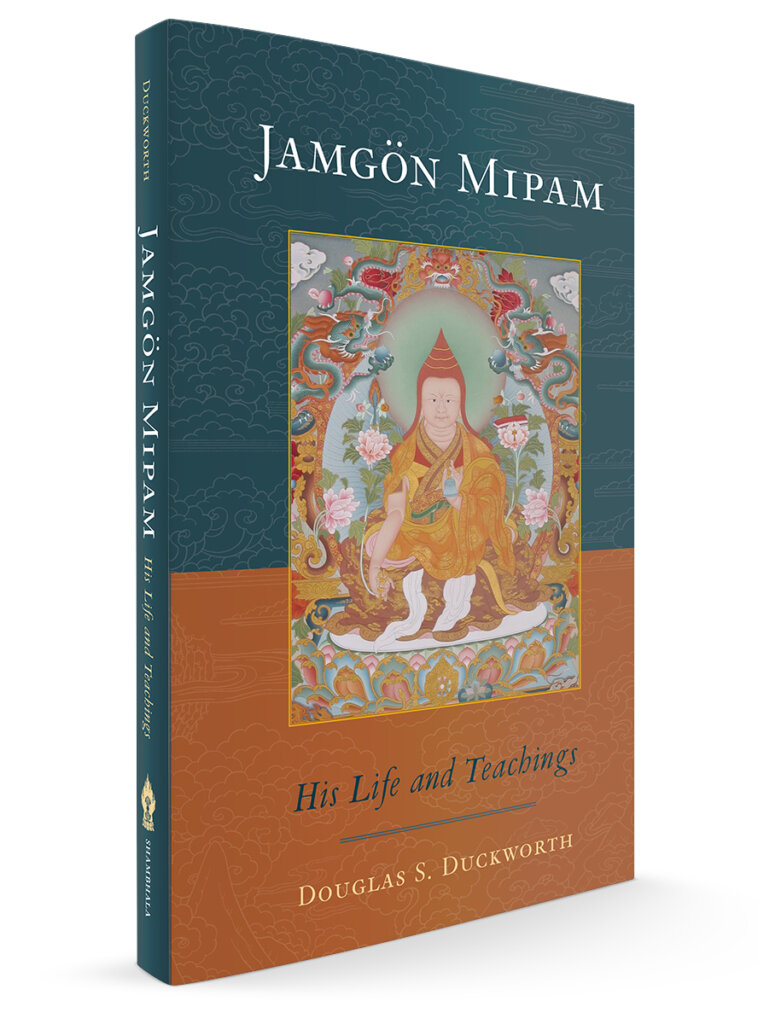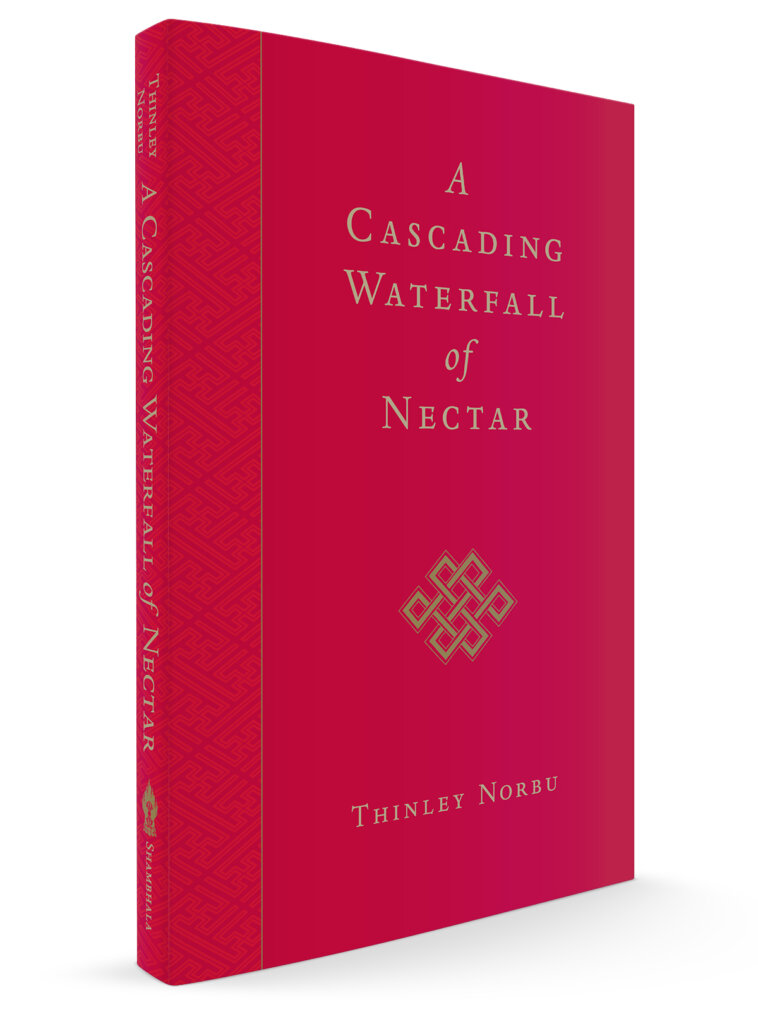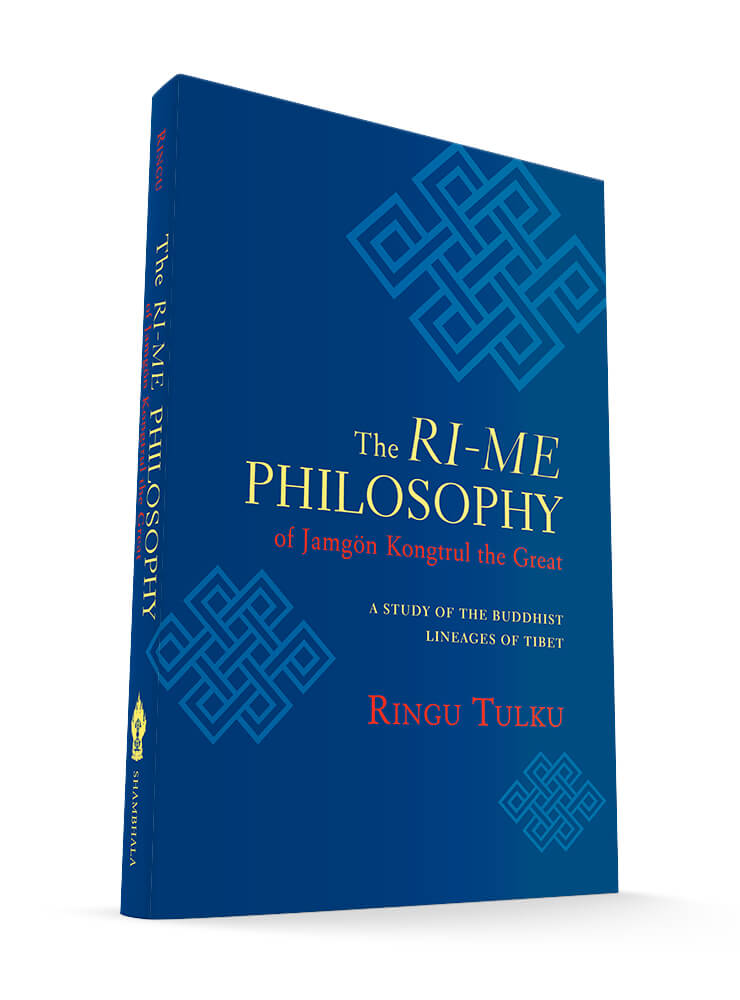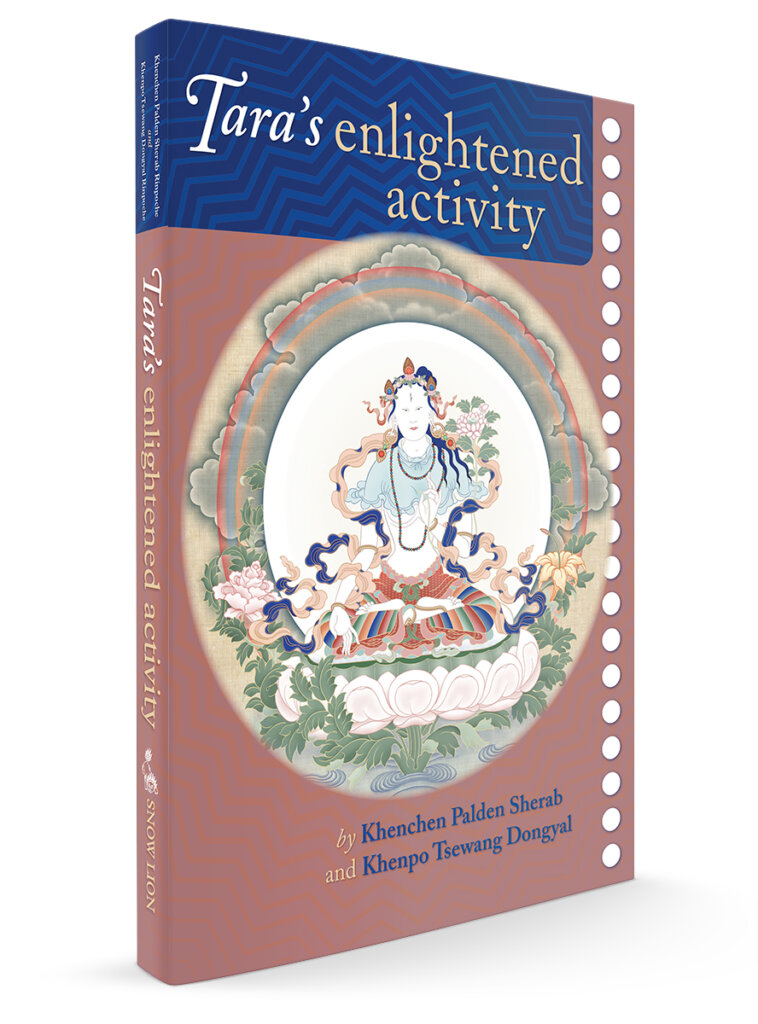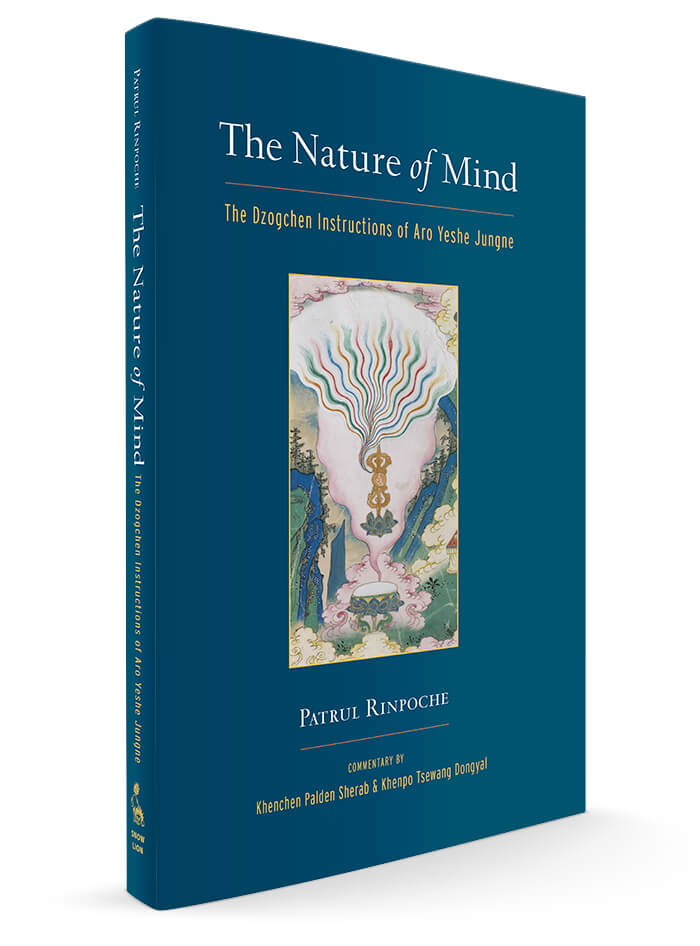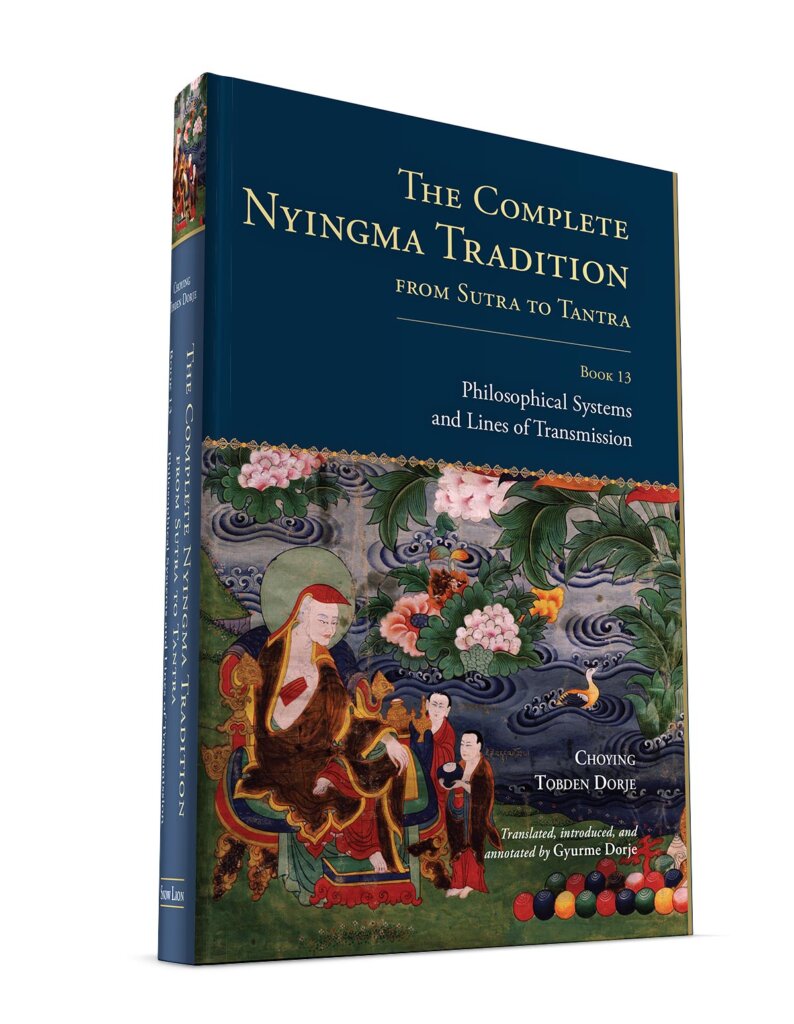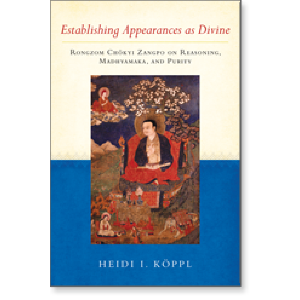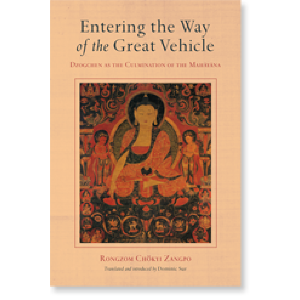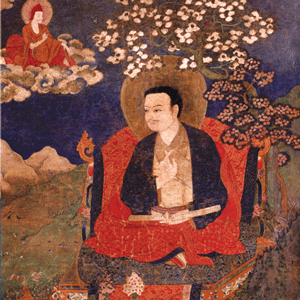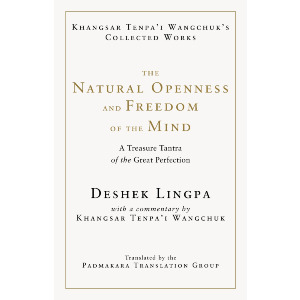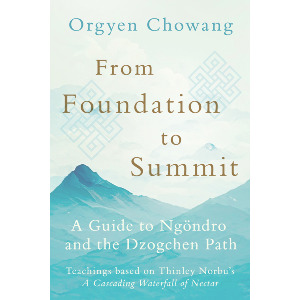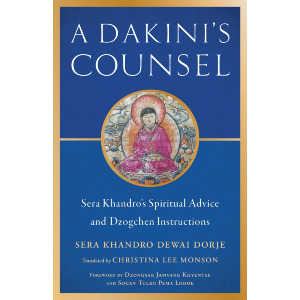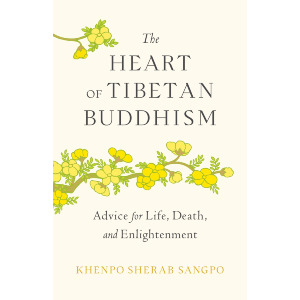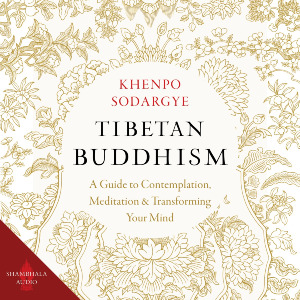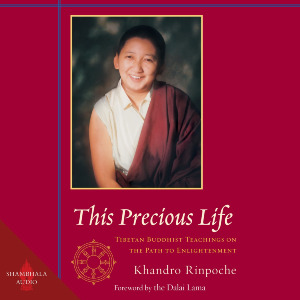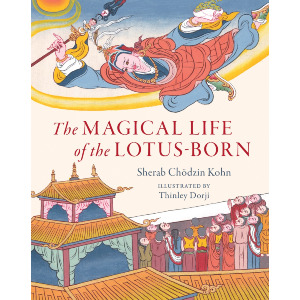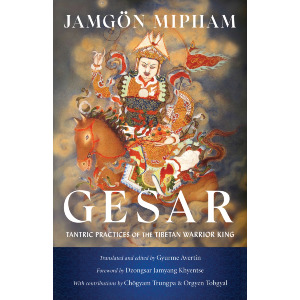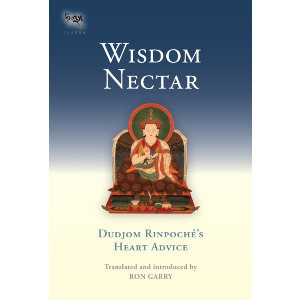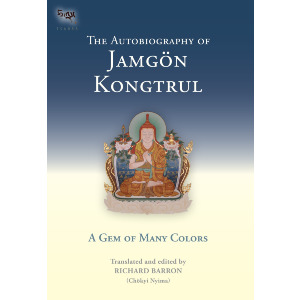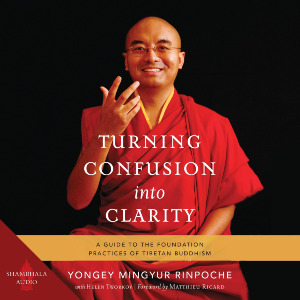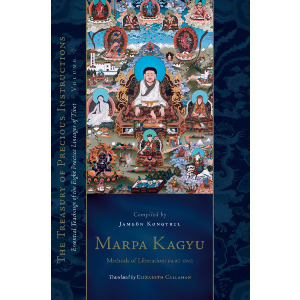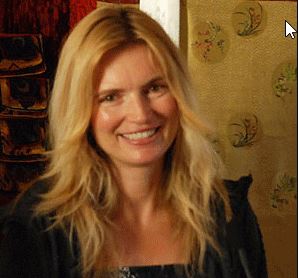

Heidi I. Koppl
Heidi I. Köppl has worked as a translator at the Ka-Nying Shedrub Ling Monastery in Nepal for more than a decade and has been a faculty member at the Kathmandu University Centre for Buddhist Studies since the Centre's inception. She is currently doing research for a doctorate degree in Buddhist Studies at the University of Lausanne.
Heidi I. Koppl
GUIDES
Rongzom Mahapandita: A Guide for Readers to Rongzompa

Related Reader Guides:
Profiles of early Indian Mahayana figures | Tibetan Masters of the 8th Century | Tibetan Masters of the 10th-11th Centuries
Nyingma | Dudjom Tersar | Longchen Nyingtig | Namcho & Palyul
___________________
Guru Rinpoche | Mandarava | Rongzompa | Longchenpa | Jigme Lingpa | Patrul Rinpoche | Rongzompa
Sera Khandro | Mipham Rinpoche | Dilgo Khyentse | Dudjom Rinpoche
We Tibetans have one crown ornament and two earrings. The crown ornament is Padmasambhava, and the two precious earrings are Milarepa and Rongzom Chenpo Chökyi Zangpo.
—Gö Lotsawa Chenpo Shonnu Pal, from The Blue Annals
Rongzom Chökyi Zangpo (1012–1088)—also known as Rongzompa, Rongzom Mahapandita, Rongzom Chozang, and Dharmabhadra— is along with Longchenpa and Mipham Rinpoche, one of the pillars of the Nyingma tradition who systematized much of the philosophical principles of the school.
A short biography is included in Cortland Dahl's Entrance to the Great Perfection:
Rongzom Chökyi Zangpo, also known as Rongzom Mahapandita, is widely regarded as one of the two greatest exponents of the unique views and practices of the Nyingma school. Along with Longchenpa, he is known as an “Omniscient One.” This rare title connotes both breadth of knowledge and depth of realization. His innate intelligence was so great, in fact, that Rongzom himself once remarked, “Since there is no teaching that I did not study, my learning is not insignificant. Yet, as I never needed to review the teachings I received more than once, neither is it great.
Rongzom was a contemporary of Atisha, Marpa Lotsawa, and many others who were instrumental in establishing new Buddhist lineages in the land of snows. He wrote extensively on a broad range of topics and demonstrated an unparalleled mastery of the Buddha’s teachings. The Indian scholars he interpreted often commented on his universal knowledge, encouraging him to write his own treatises. He was also praised by some of the greatest masters of the Sarma traditions, such as Atisha and Marpa. Echoing their sentiments, the great Gö Lotsawa wrote: “In the snowy land of Tibet, Rongzom remains unequalled as a scholar.” The greatest testament to Rongzom’s accomplishments, however, is the lasting influence he has had on the great thinkers of the Nyingma school. Mipam, perhaps the greatest Nyingma thinker of recent times, modeled his views on those of Rongzom and Longchenpa, a debt that he acknowledges repeatedly in his writings. Rongzom’s thousand-year-old legacy continues to exert a powerful influence on spirituality in Tibet.
Essential Texts by Rongzompa
Paperback | Ebook
$29.95 - Paperback
Establishing Appearances as Divine: Rongzom Chokyi Zangpo on Reasoning, Madhyamaka, and Purity
By Rongzom Chokyi and Heidi I. Koppl
Establishing Appearances as Divine, a concise treatise by the eleventh-century Tibetan Buddhist philosopher Rongzom Chökyi Zangpo, sets out to prove the provocative point that everything that appears is actually deity manifest. Many books on Tibetan Buddhism address the important themes of mind training, compassion, and proper conduct, but this penetrating study and translation of Rongzom’s text goes beyond that in its aim to bring the reader face to face with his or her pure, divine nature.
This work is described in the present-day Nyingma tradition as a commentary on the Guhyagarbha Tantra. If one accepts this classification, it would lend further testimony to Rongzom’s general fondness for the Guhyagarbha teachings and his attempt to validate these teachings through the style of discourse usually associated with the classical dialectical approach. Considering that the initial thesis of Establishing Appearances as Divine follows almost verbatim that of Padmasambhava in his Garland of Views, a treatise that itself is based on the Guhyagarbha, one may reasonably conclude that the traditional classification of Establishing Appearances as Divine as a text pertaining to the Mahāyoga class of Tantra is valid.
Entering the Way of the Great Vehicle: Dzogchen as the Culmination of the Mahayana
By Rongzom Chokyi, translated and introduced by Dominic Sur
Rongzom Chökyi Zangpo wrote this treatise in the eleventh century during the renaissance of Buddhism in Tibet that was spurred by the influx of new translations of Indian Buddhist texts, tantras, and esoteric transmissions from India. For political and religious reasons, adherents of the “new schools” of Tibetan Buddhism fostered by these new translations cast the older tradition of lineages and transmissions as impure and decadent. Rongzompa composed the work translated here in order to clearly and definitively articulate how Dzogchen was very much in line with the wide variety of sutric and tantric teachings espoused by all the Tibetan schools. Using the kinds of philosophic and linguistic analyses favored by the new schools, he demonstrates that the Great Perfection is indeed the culmination and maturation of the Mahāyāna, the Great Vehicle.
There is an interesting note about Ronzom Mahapantida ability to commit teachings to memory only be hearing them a single time in Matthieu Ricard's account of Patrul Rinpoche, Enlightened Vagabond.
"When Rongzom Chökyi Zangpo was asked about the extent of his study of Buddhist scriptures, he answered, 'I can't say I studied extensively, since most of the texts I read only once. But I also can’t say that I didn’t study, since after reading them just once, I knew them almost by heart.”
Books Featuring Rongzom Chokyi Zangpo
Hardcover | Ebook
$39.95 - Hardcover
The Ruby Rosary Joyfully Accepted by Vidyadharas and Dakinis as the Ornament of a Necklace
By Thinley Norbu Rinpoche
The Ruby Rosary is Kyabje Thinley Norbu Rinpoche's explanation of The Pearl Necklace, a lineage prayer to the main figures in the Dudjom lineage. Rongzompa was on of this series of enlightened masters. This includes a dozen pages on this pillar of the Nyingma tradition, much of which is a translation of Mipham Rinpoche's account of his life.
The section concludes with:
In brief, this master was a peerless being who resided at the level of the truly great Noble Ones, and indeed his entire sacred life story of scholarship and realization is beyond the scope of ordinary minds. For the sake of ordinary beings, only the well-known and undisputed part of the sacred biography of this paṇḍita who unlocked the eight great treasures of sublime confidence is told here [by Mipham Rinpoche], based on the writings of Dorje Wangchuk, the layman of Yolchak, who was a direct disciple of the master. These writings are found in the great Gö Lotsawa’s Blue Annals, adorned with a few small extracts from the writings of [other] Tibetan scholars of the past.
Other Works that Include Rongzompa
Paperback | Ebook
$34.95 - Paperback
Jamgon Mipam: His Life and Teachings
By Jamgon Mipham and Douglas Duckworth
The great Mipham Rinpoche relied mainly on two giants in the Nyingma tradition: Longchenpa and Rongzompa. The latter appears throughout this extraordinary work on Mipham.
Duckworth demonstrates many key features of Rongzompa's influence on Mipham:
- The view of the Guhyagarbha Tantra
- The association of “essential nature” (Tib. snying po, Skt. garbha) with the meaning of the Great Perfection.
- Mipham appropriates Rongzom’s use of reason in what he calls the “valid cognition of pure vision”, which he uses to legitimate a view of appearances as divine (see Establishing Appearances as Divine above).
Paperback | Ebook
$28.95 - Paperback
A Cascading Waterfall of Nectar
Given Ronzompa's centrality in the Nyingma tradition and as a central figure in the Dudjom lineage, it is no surprise to see him, referred to as Omniscient [Kunkhyen] Rongzompa, throughout Kyabje Thinley Norbu Rinpoche's masterpiece here.
Ronzompa's words on eternalism and nihilism, alaya, the nature of deity, Buddhahood, the nature of emptiness, and much more.
In Rosary of the View Commentary (on the Guhyagarbha)by Great Omniscient Rongzom, it says:
If it is explained here, the nature of Vajra Kuntuzangpo
is the enlightened mind.
The nature of mind is enlightened, so it is vajra.
So therefore, from all to all, there are no phenomena
to abandon or throw away,
So it is always noble. That is why it is called Kuntuzangpo.
Paperback | Ebook
$24.95 - Paperback
The Ri-me Philosophy of Jamgon Kongtrul the Great: A Study of the Buddhist Lineages of Tibet
By Ringu Tulku
Ringu Tulku quotes Rongzompa's Points to Remember about the View at length when disussing how the higher and lower views relate to eachother. Towards the end of this several page section, Rongzompa explains,
All the Buddha’s teachings are of one taste and one way; nothing is excluded within the state of vast equality. For example, all the small streams flow into large rivers and then accompany the large rivers to flow into the ocean. Within the vast ocean, all the rivers have the same taste of salt. Similarly, all the small entrances of the lower yanas are small rivers of understanding personal selflessness, which wash away the dirt of the belief in substantial entities. They join the large rivers of the Mahayana sutras and all of them end up in the great ocean of Dzogpa Chenpo. There is not even a particle of dust that does not become of one taste with this great, vast equality.
Ringu Tulku also explains how their is a Rong Luk (tradition of ROngzompa) in explaining the Guhyagarbha tanta, stemming from his receiving the teachings from the lineages of Guru Rinpoche, Vairocana, and Vimalamitra.
Regarding the inner tantras, Rongzompa seven transmission lineages, ennumerating:
- Oral tradition or kama
- Earth terma
- Rediscovered terma
- Mind terma
- The Hearing Lineage
- The Pure Vision lineage
- Teachings recollected from past lives.
Paperback | Ebook
$16.95 - Paperback
Tara's Enlightened Activity: An Oral Commentary on The Twenty-one Praises to Tara
By Khenchen Palden Sherab and Khenpo Tsewang Dongyal
In their definitive work on the Twenty-one Taras, the Khenpo brothers discuss how Rongzompa was the first recorded source of Tara teachings that are still preserved in Tibet. Rongzompa’s lineage was passed down in the Nyingma School and received by Jigme Lingpa in the eighteenth century. Jigme Lingpa revealed a famous terma on the wisdom dakini Yeshe Tsogyal. Its condensed title is Dechen Gyalmo, or “Queen of Great Bliss.” He taught that externally we practice on Yeshe Tsogyal as she is, but inwardly we practice on the Twenty-one Emanations of Tara.
Paperback | Ebook
$21.95 - Paperback
The Nature of Mind: The Dzogchen Instructions of Aro Yeshe Jungne
By Patrul Rinpoche, Khenchen Palden Sherab, and Khenpo Tsewang Dongyal
Rongzompa makes a brief appearance here when the Khenpo brothers discuss his role in the Aro tradition that is the focus of this book.
Two lineages sprang from the great master Aro Yeshe Jungne. The first one began with these:
- Aro Yeshe Jungne
- Yazi Bonton of Kham
- Drulsha Gyalpo of Kharab
- Drumshig Sherab Monlam of Wu
- Chogro Sangkar of Tsam
- Rongzom Chokyi Zangpo
Rongzompa then incorporated the Aro teachings into the Nyingma kama. As a result, as the Nyingma kama flowed through the centuries into the present day, naturally the Aro teachings flowed with it.
Paperback | Ebook
$39.95 - Hardcover
The Complete Nyingma Tradition from Sutra to Tantra, Book 13: Philosophical Systems and Lines of Transmission
By Choying Tobden Dorje. tTranslated by Gyurme Dorje, with contributions by Lama Tharchin Rinpoche
Rongzompa makes a brief appearance here when Choying Tobden Dorje describes the transmission in Tibet of the Father Tantra cycle of Yamāri.
Rongzom ChoZang "attended upon Upālaśrīmitra [elsewhere identified as Upaya Shri Mitra] , and he translated the tantras of the Black [Slayer of Death] and Vajrabhairava and others, and also undertook their exegesis."
Additional Resources on Rongzompa
Lotsawa House has several important translations of Ronzompa's work including The Black Snake Discourse. 

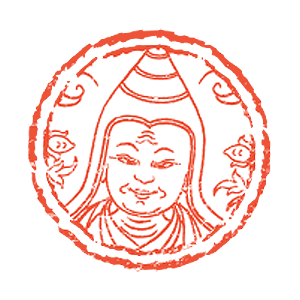 The Treasury of Lives also has a profile of Rongzompa.
The Treasury of Lives also has a profile of Rongzompa.
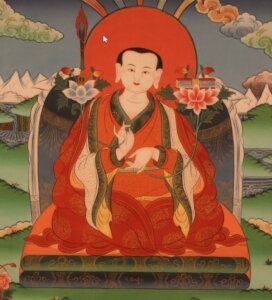
Heidi Koppl on the Importance of Rongzom Mahapandita

Shambhala Publications: What inspired you to take on this text?
Heidi Koppl: While I was living at my teacher Chökyi Nyima Rinpoche's monastery in the Kathmandu Valley in the early 1990s, Khenpo Chöga Rinpoche was teaching there, and I had the opportunity to attend some of his wonderful classes. This was the first time that I heard about Rongzom and his teachings on the unique Vajrayana view. As I began to study the works of Ju Mipham Rinpoche, I then noticed how he at crucial stages often refers precisely to Rongzom. So I quite quickly developed the wish to study Rongzom's writings myself.
Chökyi Nyima Rinpoche always stresses the importance of pure perception, explaining that all progress on the path of secret mantra depends on our ability to discover and maintain pure perception. During my graduate studies at the University of Copenhagen I therefore decided to concentrate on Rongzoms' works, and especially on this one short text that intrigued me tremendously. In Establishing Appearances as Divine Rongzom sets out to prove, through reasoning, the Vajrayana thesis that all appearances are pure and perfect. Was it really possible to do such a thing? Is it possible to establish a logical foundation for this all-important issue? I really wanted to find out.
Rongzom explains that when we are less disturbed by negative mental factors what appears to us is actually more true than otherwise. We then begin to get the sense that purity and divinity are something to be discovered rather than conjured, and with that can come a great deal of confidence and perspective in one's Vajrayana practice.
SP: How has it helped you in your practice? How is a text like this supposed to influence the mind of a practitioner?
HK: Merely studying and researching the topic of pure perception has helped me to understand just how deep this issue goes. Approaching an understanding of experience as intrinsically pure-in fact, divine-is not a process of cultivating a naïve perspective, and we are not trying to trick ourselves into believing something that actually isn't true. Experiencing the Vajrayana perspective has more to do with understanding the fundamental nature of things and appreciating the fact that everybody's basic nature is pure and perfect. In spite of our fleeting, cloud-like obscurations we can begin to understand this by just paying attention to the way the contents of our experience actually change depending on how we look at things. It's not just that our frame of mind influences the phenomena that appear to us so that, for example, things look better when we are not feeling very nervous or angry. Rongzom explains that when we are less disturbed by negative mental factors what appears to us is actually more true than otherwise. We then begin to get the sense that purity and divinity are something to be discovered rather than conjured, and with that can come a great deal of confidence and perspective in one's Vajrayana practice. The sun always shines, so to speak, even when we cannot see its light coming through the clouds. Merely understanding this can have a profound transformative effect on the way we look at, basically, everything. Both Mipham and Rongzom stress that purity and divinity have always been the case. It is not that we have to make things pure. Perfection is just the way things really are. Gaining certainty in this with the help of the logical arguments set forth by Rongzom can surely take your spiritual practice to another level.
SP: Rongzompa, as he is popularly called, is considered one of the most important figures in the systematization of Nyingma philosophy and practice. How is he discussed and studied today, both in traditional lay and monastic contexts, in Asia and in academia in the West?
HK: Although Rongzom's works are extremely relevant to the study of Varjayana in general, he is mostly referred to in the Nyingma school of Tibetan Buddhism. And among Nyingma scholars Rongzom is often seen and discussed through a Mipham-lens. This is also something I discuss in the book. Sometimes what happens is that we just take a look at what Mipham has to say about Rongzom and then classifiy him accordingly. For instance, though he was of the Prasangika Madhyamaka school, when we look at his own extant works, we notice that Rongzom never refers to Candrakirti or his Madhyamaka. Though he is tremendously venerated, it seems that Rongzom is not very widely studied in modern Nyingma colleges. In academia, Orna Almogi has produced a large survey on Rongzom, but in general very few studies have emerged around him.
SP: What was his influence on later Nyingma writers, like Longchenpa and Mipham Rinpoche?
HK: Mipham Rinpoche himself mentions Rongzom as a central source of inspiration. And, for example, his development of pure vision as a cognitive tool, or as a pramÄá¹a, is clearly influenced by Rongzom. To what degree Longchenpa was influenced by Rongzom is still a very open issue.
SP: There is so little of Rongzompa's work in English, yet almost every Nyingma lama has his collected works on their shelves. Do you have plans to translate any more of his work into English?
HK: Yes, if my work schedule permits, I would very much like to continue translating Rongzom. I am intrigued by Rongzom's unconventional style of explaining important Vajrayana themes through reasoning. His fearless approach of taking up difficult topics that seem inaccessible to our logical intellect is for me a hallmark of his powerful scholarship. It would be a shame if his writings were not translated into English for a modern audience. It seems these days more important than ever to be able to also understand logically the depth and the subtle workings of the Vajrayana practices that we train in on a daily basis.
SNOW LION NEWSLETTER ARCHIVE
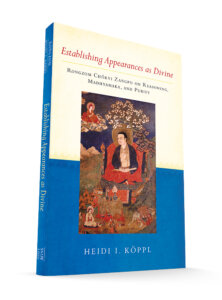
Rongzompa's Establishing Appearances as Divine

Rongzom explains that the view of the inseparability of the two truths begins to dawn with the tantras, yet it is only fully perfected in the Great Perfection. When an imaginary opponent inquires why the Madhyamaka does not set forth such a view of inseparability, Rongzom states that as long as one believes both truths to be true, one will never succeed in discarding the dualistic mindset. One could propose that ultimately the two truths are inseparable without giving up the idea that illusory phenomena exist on the relative level. Thus, even when attempting to establish dharmata as nondual, one would still retain a dualistic perspective. The person who falls into this trap, Rongzom continues, might argue that what exists by way of imputation is ultimately free from mental constructs and therefore similar to illusion, yet he will not assert the same on the relative level, for he cannot accept that phenomena should lack substantial efficacy even conventionally. Thus, even while examining the characteristics of substantial existence and concluding that indeed such existence is unestablished, one will still not have mentally discarded the two ontological modes. Rongzom illustrates his point by referring to appearances (snang ba): as long as one assumes that there is an appearance that can be taken as the subject (chos can, dharmin) or used as an illustration (mtshan gzhi, drstanta) in argument, and as long as one considers this property or illustration to be free from mental constructs (spros bral, nisprapañca) and thus mere illusion, one still conceptualizes the characteristics of appearances. Therefore, the view of great equality remains yet to be accomplished, for by identifying a particular appearance and then concluding that this indeed is beyond mental constructs, the appearance aspect (snang ba’I cha) and the empty aspect (stong pa’I cha) become temporarily separated.
These explanations on the Madhyamikas’ lack of realization of the inseparability of the two truths are very telling, for they specify that appearances’ aspect and their empty nature must be seen as inseparable for the view to qualify as great equality. Thus any objectification of the relative truth that specifies “authentic” (yang dag) relative principles would separate the two truths and prevent one from the sudden, full, and direct realization of the actual nature.
The view of equality is also explained as equality inseparable from purity. Let us consider a statement from Rongzom’s commentary to the Garland of Views as Oral Instructions: “The Madhyamikas are attached to the relative truth as being the experiential domain of impure characteristics.”
Here Rongzom not only objects to the Madhyamaka belief in an authentic relative truth and its view of the two truths as separate identities, but also to the view of the relative as impurity. This underscores Rongzom’s tantric perspective and his commitment to purity. Rongzom draws the dividing lines between Sutra and Mantra based on a) whether relative truth is reified as distinct from the ultimate, as in the case of Madhyamaka, and b) whether, on the relative level, appearances are perceived as purity (Mantra) or impurity (Sutra). Thus, for Rongzom, there is a clear connection between objectification of the relative and the view of impurity. For a tantrika like Rongzom, the Madhyamaka separation of ultimate and relative truths and the ensuing division of the relative into authentic and inauthentic aspects disparage the central esoteric notions of unity, equality, and purity. By setting forth an authentic relative and ascribing it a more genuine mode of existence than what is dismissed as the mistaken relative, one is blinded to the ultimate truth of great equality. Moreover, this equality is not realized, as the Madhyamikas would have it, by a negation of relative phenomena. The ultimate equality, the nature of all phenomena, is inseparable from relative appearances, the appearances of great purity. In conclusion, according to Rongzom’s tantric perspective, appearances are by nature pure and therefore need not be negated. As there is nothing to discard within their purity, everything remains as great equality. If phenomena were not universally pure they could not be equal, and unless everything is absolutely equal, one cannot establish the truth of purity.


